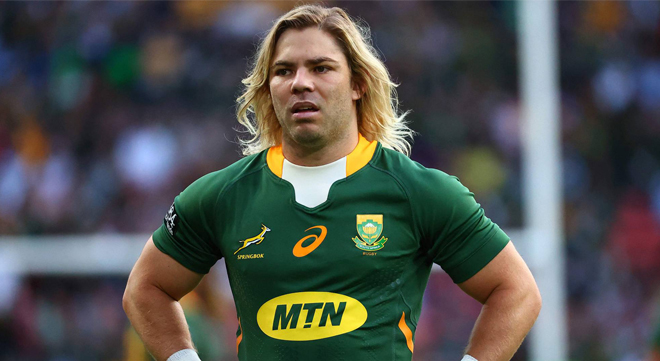A Budget Insurance TV advert featuring rugby player Faf de Klerk in his Speedo is not offensive, the directorate of the Advertising Regulatory Board (ARB) has ruled.
The ARB is an independent body set up by the marketing and communications industry. Submission to its jurisdiction is voluntary, and the ARB does not have jurisdiction over non-members.
Budget Insurance does not belong to the ARB. However, the ARB’s Memorandum of Incorporation provides for it to consider and rule on the advertising of non-members for the guidance of its members.
Rulings by the ARB are binding on all broadcasters (including those that do not belong to the ARB) in terms of the Electronic Communications Act.
DStv flighted the 10-second advert during its rugby broadcasts.
Two members of the public complained to the ARB that the image of De Klerk in his “underwear/costume” was distasteful and caused them discomfort while watching rugby with friends and family.
One of the complainants said De Klerk’s “private parts are clearly visible”, which was inappropriate and off-putting.
Both complainants argued that the advert did nothing to promote Budget’s brand.
Budget’s response
In its response, Budget said it is not a member of the ARB.
Addressing the merits of the matter, the insurer submitted the following:
- De Klerk is wearing a Speedo with the South African flag, an image that cannot reasonably be regarded as offensive in an open and democratic society.
- There are numerous examples of other sports personalities wearing Speedos, and people are permitted to wear them on public beaches, further demonstrating that such attire is not regarded as offensive.
- De Klerk gained “notoriety” in 2019 when he met Prince Harry in similar underwear after South Africa’s Rugby World Cup victory over England. The advert merely sought to leverage that “light-hearted memory”. There was no intention to offend or promote sexually inappropriate behaviour.
- People have varying levels of tolerance for Speedos. However, the fact that such clothing upsets a few people cannot justify the removal of the advert. The imagery is not explicit or sexual in nature and is not contrary to public or sectoral values.
‘The average, reasonable South African’
The ARB considered whether the advert contravened clause 1 of section II (offensive advertising) of its Code of Advertising Practice.
Clause 1 states that advertising must not offend against good taste, decency, or sectoral values unless it is reasonable and justifiable in an open and democratic society. Advertising should not cause serious, widespread, or sectoral offence.
It also states: “The fact that a particular product, service or advertisement may be offensive to some is not in itself sufficient grounds for upholding an objection.”
The clause compels the ARB’s Directorate to consider, inter alia, the context, medium, likely audience, the nature of the product or service, prevailing standards, degree of social concern, and public interest when considering allegations, the ARB’s decision said.
The ARB said the Directorate is mandated to determine whether advertising is offensive by considering how the average, reasonable South African citizen is likely to interpret or perceive the material.
The image in question is shown in homes all over the country regardless of whether the viewers are at the beach or wear similar swimming attire. Furthermore, the Speedo is a relatively revealing outfit, and some people might be uncomfortable wearing such clothing in public.
But these were not the only factors that had to be considered, the ARB said.
Whether or not people approve, men in Speedos can be seen at any beach or public swimming pool. It is not a socially unacceptable sight in the correct context.
The ARB agreed with Budget that the advert should be seen in the context of De Klerk’s meeting with Prince Harry after the 2019 Rugby World Cup. “At the time, Faf (and a handful of other players) was wearing a similar pair of underwear bearing the South African flag. It is therefore not unreasonable to portray Faf in a South African Speedo when rugby matches are being broadcast.”
The Directorate also agreed with Budget that the image is not sexual in nature, does not place particular emphasis on inappropriate body parts, and contains no imagery, movement, dialogue, or text that could reasonably be regarded as offensive to the average, reasonable South African.
“Offence, by its very nature, is subjective, and the Directorate needs to balance the complainants’ discomfort and perceived offence with what it believes the average, reasonable person’s view would be when confronted with this image.
“Given the lack of any gratuitous or graphic content and given the relevance of the image in a rugby context, the Directorate is inclined to agree that the average, reasonable person would not find the image offensive in a manner that the code seeks to prevent,” the ARB said.



